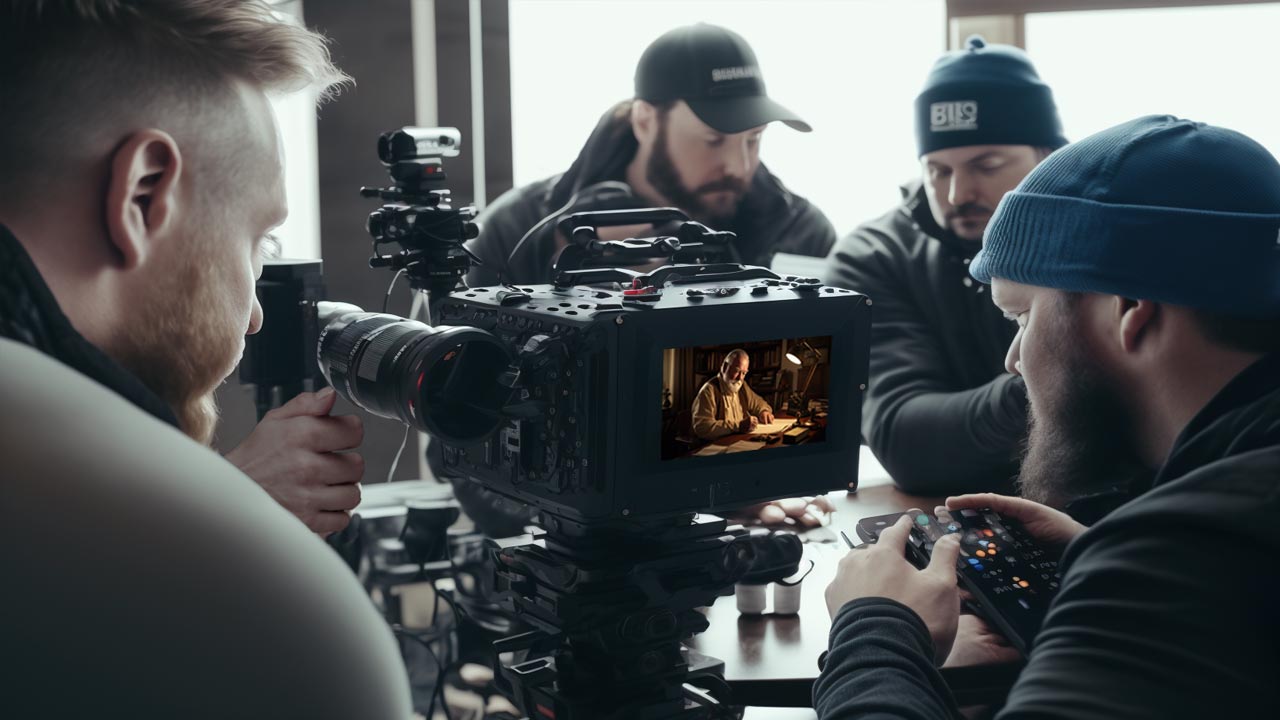Content is king and video marketing has emerged as a compelling method of storytelling for brands across industries. This article will dive deep into the intricate process of transforming an idea from script to screen in video marketing, examining the various elements that create compelling narratives that captivate audiences and drive business growth.
This comprehensive guide will shed light on the art of storytelling in video marketing, walking you through the different stages and techniques involved. It is not just about crafting a script or shooting a video; it is about weaving a story that resonates with the audience and aligns with the brand’s identity.
From understanding the core concepts of storytelling and its importance in video marketing to the practical aspects of scripting, shooting, and post-production, you will learn how to create a compelling video marketing campaign from scratch. Whether you are a marketer looking to bolster your brand’s online presence, a business owner aiming to engage more effectively with your target audience, or a video production enthusiast looking to enhance your skills, this guide offers valuable insights and actionable tips that can be implemented in your video marketing strategy.
Moreover, the article will explore various case studies that illustrate the power of effective storytelling in video marketing. These real-world examples will provide you with a clear picture of how concepts and techniques discussed in this guide can be applied to create impactful video content that stands out in the competitive digital landscape.
Table of Contents
- The Power of Storytelling in Video Marketing
- Understanding the Core Concepts of Storytelling
- From Idea to Script: Crafting a Compelling Narrative
- Shooting the Video: Capturing Your Story
- Post-Production: Polishing Your Narrative
- Case Studies: The Success Stories
- FAQ’s, Frequently Asked Questions/Answer
- Final Thoughts
- Sources
1. The Power of Storytelling in Video Marketing
In a world saturated with information and advertising, it is no longer enough to simply present facts about a product or service. Today, to truly capture an audience’s attention, businesses must engage their customers on a deeper, more emotional level. This is where the power of storytelling in video marketing comes into play.
1.1 Why Storytelling Matters
Storytelling is a fundamental human experience. From the earliest cave paintings to modern digital narratives, stories have always been our primary means to communicate, educate, and entertain. They allow us to convey complex ideas in relatable ways, evoke emotions, and create a sense of connection and empathy. In the context of marketing, storytelling serves as a tool to build relationships with customers, humanize a brand, and differentiate it from competitors.
In video marketing, storytelling leverages the unique strengths of the medium—its ability to combine visual imagery, sound, motion, and time—to create immersive experiences that can engage viewers on multiple sensory levels. It enables marketers to show rather than tell, creating a more compelling and memorable message.
1.2 Role of Video in Marketing
Video has become an indispensable part of marketing strategies in the digital age. According to a report by Wyzowl, as of 2021, 86% of businesses use video as a marketing tool, a significant increase from just 63% in 2017. This rise can be attributed to the numerous benefits of video content, including its ability to boost online visibility, improve SEO, increase customer engagement, and enhance conversion rates.
Moreover, video content is highly versatile and can be used across various platforms, from social media to websites to email campaigns, providing multiple touchpoints for brands to reach their target audience.
1.3 Benefits of Video Storytelling
Storytelling in video marketing offers multiple benefits:
- Emotional Connection: Stories can stir emotions, and these emotions can create strong memories associated with a brand. This emotional connection can drive brand loyalty and encourage customer advocacy.
- Brand Identity: Storytelling allows brands to present their values, mission, and personality in an engaging way, fostering a stronger brand identity.
- Differentiation: In a crowded market, a well-told story can set a brand apart from its competitors. It offers a unique selling proposition that goes beyond price or product features.
- Information Retention: Information delivered as a story is more likely to be remembered. Studies show that we remember facts up to 22 times more when they are part of a story.
- Engagement: Video stories are engaging and shareable. They can generate comments, likes, shares, and other forms of user engagement, increasing the reach and effectiveness of marketing campaigns.
In the following sections, we will delve into the core concepts of storytelling and how to apply them in video marketing—from conceptualizing and scripting your story, to shooting and editing your video, to analyzing the success stories in the industry.
2. Understanding the Core Concepts of Storytelling
Storytelling is a universal language that spans across cultures and generations. It is an art form that has timeless principles, which when understood and applied effectively, can greatly enhance your video marketing efforts.
2.1 Elements of a Good Story
A good story, regardless of the medium, usually includes several key elements:
- Character: This is the hero of your story. In marketing, this is often the customer or the user of your product or service. It’s important to create characters that your audience can relate to and empathize with.
- Conflict: This is the challenge or problem that the character faces. It serves as the driving force of the story, creating tension and interest.
- Resolution: This is how the conflict is resolved, usually involving the character overcoming their challenge. In marketing, this often involves the use of your product or service.
- Theme: This is the underlying message or lesson that the story conveys. It gives the story depth and meaning.
Remember, a story in a video marketing context should not only be interesting and engaging but should also align with your brand’s message and values.
2.2 Understanding Your Audience
Understanding your audience is crucial to effective storytelling. It allows you to craft stories that resonate with your viewers, meet their needs and expectations, and influence their perceptions and behaviors.
To understand your audience, you need to know their demographics (age, gender, location, etc.), psychographics (interests, attitudes, behaviors), their needs and challenges, and their media consumption habits. This information can guide you in creating relevant and relatable characters, conflicts, and resolutions in your story.
2.3 Aligning Your Story with Your Brand
Your story should not just be a random tale; it should be a reflection of your brand’s identity. It should convey your brand’s values, mission, and unique selling proposition. This alignment between your story and your brand helps create a consistent brand image and builds trust with your audience.
To align your story with your brand, consider the following:
- What is the core message or value proposition of your brand?
- How does your product or service fit into the lives of your customers?
- What emotions do you want to associate with your brand?
- How do you want your audience to perceive your brand after watching your video?
Answering these questions can help you create a story that not only captures your audience’s attention but also reinforces your brand identity and message.
3. From Idea to Script: Crafting a Compelling Narrative
The journey from an initial idea to a fully-formed script is a crucial phase in video marketing. Here, the groundwork is laid for the narrative that will eventually captivate your audience.
3.1 Conceptualizing Your Story
Story conceptualization involves brainstorming and consolidating ideas into a clear and compelling story arc. Start by identifying the message you want to convey, then create a basic structure for your story. Remember to keep your audience in mind: What do they care about? What problems do they face? How can your product or service solve their problems?
This phase often involves creating a storyboard or a visual representation of your story. This can help you visualize the flow of your narrative and how it will translate to the screen.
3.2 Writing the Script
Writing a script for a video involves more than just dialogue. It includes descriptions of settings, actions, camera angles, and even sound effects. All these elements work together to create a vivid, engaging narrative.
Your script should clearly articulate your story’s progression, ensuring it maintains interest and emotional engagement. Use language that your audience can easily understand and relate to. Remember to be concise; every second counts in video marketing.
While writing, keep these things in mind:
- Show, Don’t Tell: Use visual imagery and actions to convey your message, rather than relying solely on dialogue.
- Keep it Simple: Avoid jargon and complex language. The message should be easily digestible to your audience.
- Create an Emotional Arc: Ensure your story evokes emotions. This could be excitement, joy, surprise, or even sadness. Emotions make stories memorable.
3.3 Reviewing and Refining Your Script
Once your first draft is complete, review and refine it. Cut out unnecessary elements, clarify confusing parts, and make sure your message is conveyed effectively. It may take several rounds of revision to get your script just right.
Feedback is crucial at this stage. Share your script with colleagues, friends, or even members of your target audience, and be open to their suggestions. They might provide insights that you hadn’t considered, helping you to further enhance your narrative.
Ultimately, your script should serve as a detailed roadmap for your video, providing clear directions for the production team, and setting the foundation for an engaging and effective video marketing story.
4. Shooting the Video: Capturing Your Story
With a solid script in hand, the next step in video marketing is the production phase. This is where you bring your story to life, capturing it on camera.
4.1 Pre-Production
Pre-production involves all the planning and preparation before the actual shooting begins. This includes:
- Casting: Select actors who can convincingly portray your characters. Remember, your characters are the ones your audience will connect with, so it’s crucial to get the casting right.
- Location Scouting: Find locations that best fit the settings described in your script. Consider factors like lighting, noise, and permissions needed to shoot there.
- Creating a Shot List or Storyboard: This is a visual representation of all the shots in your video, which helps ensure you capture every necessary scene and angle.
- Planning Your Schedule: Determine the shooting order, taking into account factors like actors’ availability, lighting conditions, and location access.
4.2 Production
Production is the actual shooting of the video. Here are a few things to keep in mind during this stage:
- Follow Your Script and Shot List: Ensure you capture all necessary scenes and angles as planned. However, be open to capturing spontaneous moments that could add value to your video.
- Ensure High-Quality Audio and Video: Use good quality equipment to ensure clear video and audio. Poor quality can detract from your story and harm your brand image.
- Direct Your Actors: Ensure your actors understand their characters and the emotions they need to portray in each scene.
4.3 Challenges and Solutions in Production
Producing a video can be challenging. You might encounter issues with lighting, unexpected background noise, or even uncooperative weather. It’s important to be flexible and ready to solve any issues that arise. Having backup plans, like an alternative shoot location or additional shoot dates, can help mitigate these issues.
Remember, the goal of this stage is to capture your story as effectively as possible. Every shot should contribute to the narrative and help convey your brand’s message. With careful planning and execution, you can ensure your video production goes smoothly and results in a compelling video that captivates your audience.
5. Post-Production: Polishing Your Narrative
Post-production is the final stage of video creation, where all the individual elements come together to form a cohesive, engaging narrative. It involves editing the footage, adding sound effects and music, and making sure the final product aligns with your brand and message.
5.1 Video Editing
Video editing is the process of arranging and manipulating video clips to create a structured narrative. This includes selecting the best shots, determining the sequence of scenes, and adding transitions to ensure the story flows smoothly.
Remember that pacing is crucial in video storytelling. Too fast, and your audience might struggle to keep up; too slow, and they might lose interest. Strike a balance that suits your narrative and keeps your audience engaged.
5.2 Sound Design
Sound plays a vital role in video storytelling. It helps set the mood, emphasize key moments, and enhance the overall viewing experience. This includes background music, sound effects, and dialogue.
Choose music that complements the tone of your video. Sound effects should be used to enhance the reality of the scenes, and dialogue should be clear and audible. In some cases, you might need to record additional dialogue in a studio (a process known as ADR, or Automated Dialogue Replacement) to ensure clarity.
5.3 Color Grading and Visual Effects
Color grading is the process of altering and enhancing the color of your video. It can help create a specific mood, draw attention to certain elements, and ensure visual consistency throughout your video.
Visual effects (VFX), on the other hand, can be used to add elements that weren’t captured during shooting. This could be anything from simple text overlays to complex CGI (Computer-Generated Imagery).
5.4 Review and Feedback
Once your video is edited, review it carefully. Check for any inconsistencies or errors, and ensure it aligns with your script and fulfills your objectives.
Just like in the scripting stage, feedback is essential. Share your video with others and consider their suggestions. Remember, your video is meant for your audience, so their perspective is invaluable.
5.5 Exporting and Optimizing Your Video
Finally, export your video in the appropriate format and resolution for your chosen distribution platform. Each platform may have different specifications, so be sure to do your research.
Optimization also involves adding relevant metadata like titles, descriptions, and tags. This can improve your video’s visibility on search engines and within the platform itself.
Post-production requires a keen eye for detail and a deep understanding of your story and audience. With careful editing and refinement, you can transform your raw footage into a polished video that effectively tells your story and resonates with your audience.
6. Case Studies: The Success Stories
Examining successful video marketing campaigns can provide invaluable insights into effective storytelling techniques. Here are three examples of brands that have leveraged the power of storytelling in their video marketing.
6.1 Google: “Parisian Love”
In 2009, Google released a short video ad called “Parisian Love”. In the video, a user’s journey is narrated through a series of Google search queries, from studying abroad in Paris, to falling in love, to starting a family. Despite its simplicity, the video effectively tells a compelling story that resonates with viewers, highlighting the brand’s value in facilitating life’s various journeys.
Key Takeaway: A good story doesn’t need to be complex. Sometimes, simplicity is more effective in connecting with the audience and conveying the brand message.
6.2 Dove: “Real Beauty Sketches”
Dove’s “Real Beauty Sketches” campaign became a viral sensation in 2013. The video features an FBI-trained sketch artist drawing women first based on their own descriptions, and then based on others’ descriptions. The difference between the two sets of sketches is striking and powerfully illustrates the campaign’s message about self-perception and beauty.
Key Takeaway: Stories that touch on universal human experiences or emotions can deeply resonate with audiences, leading to high engagement and shareability.
6.3 Airbnb: “Wall and Chain”
Airbnb’s “Wall and Chain” video tells a poignant story of a woman traveling to Berlin and staying at an Airbnb apartment, which, unbeknownst to her initially, is in the same building where her father was stationed as a guard during the Cold War. The video beautifully conveys the brand’s value proposition of providing unique and personal travel experiences.
Key Takeaway: Storytelling can be an effective way to convey a brand’s unique selling proposition, especially when it’s woven into a compelling and emotionally-engaging narrative.
Through these case studies, it’s clear that effective storytelling in video marketing involves creating a narrative that not only engages the audience but also aligns with the brand’s values and message.
Video Sources Opens in a new tab…
FAQ's
Here are some frequently asked questions about storytelling in video marketing.
Final Thoughts
The art of storytelling in video marketing is not just about relaying information; it’s about creating a connection between your brand and your audience. This connection is established through the power of shared experiences, emotions, and values that your story conveys. Thus, the most important takeaway from this article is that effective video storytelling is a delicate blend of creativity, understanding your audience, and aligning your story with your brand’s core message.
As you venture into the realm of video marketing, remember that your goal is not just to tell a story but to tell the right story—one that resonates with your audience and helps them form a deeper connection with your brand. The process from script to screen is a journey, filled with opportunities for creativity and innovation, but it’s also one that demands a strategic approach, meticulous planning, and careful execution.
Therefore, to create an effective video marketing campaign, focus on crafting a compelling narrative, capturing your story in a way that appeals to your audience, and polishing your narrative in post-production to ensure that the final product is engaging, coherent, and aligned with your brand identity. Each step is crucial and contributes to the overall effectiveness of your video marketing strategy.
Above all, be patient. Mastering the art of storytelling in video marketing takes time, practice, and continuous learning. As you learn more about your audience and your brand, you’ll be better equipped to tell stories that truly matter and make a lasting impact.
Sources
- “Storytelling in Video Marketing: Why it Matters and How to Do it Right.” Hootsuite
- “The Ultimate Guide to Video Marketing.” HubSpot
- “Crafting a Story for Video: The Power of Creative Storytelling.” Wistia
- “The Role of Storytelling in Video Marketing.” Forbes
- “From Script to Screen: A Guide to Video Production.” Vimeo
- “Case Studies in Video Marketing.” Vidyard








